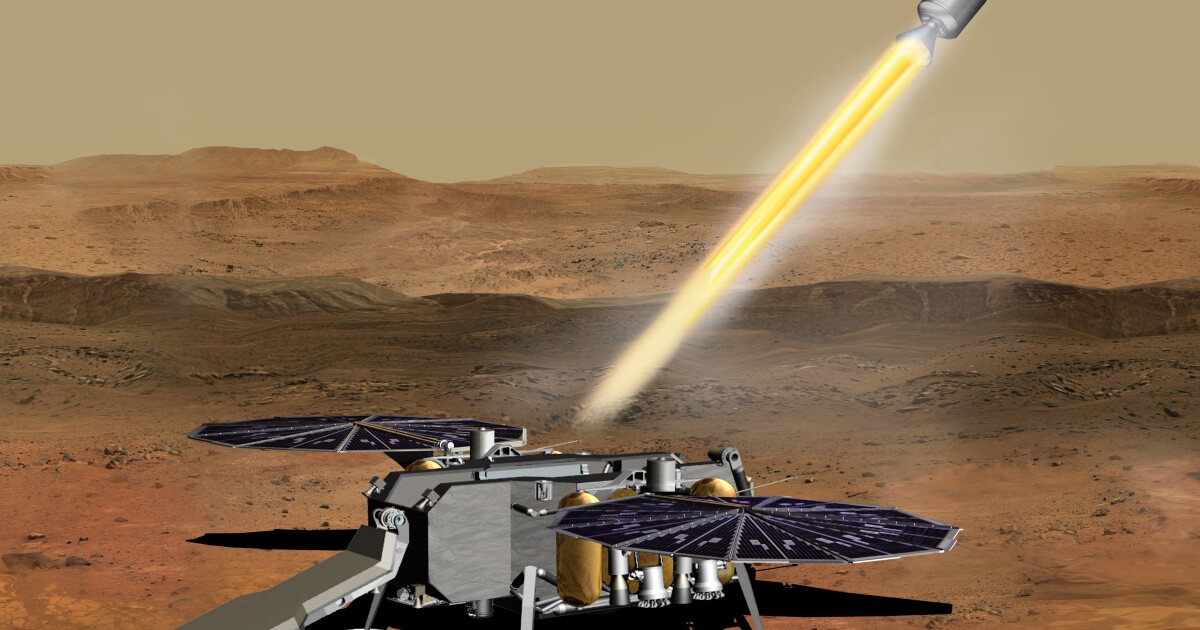
NASA’s proposed budget builds toward a future when earthlings will set foot on Mars. And in the meantime, it takes the next big step toward bringing a little bit of Mars back to Earth.
NASA Administrator Jim Bridenstine on Monday unveiled a $25.2-billion plan that would send astronauts back to the moon by 2024 as part of the space agency’s Artemis program, and ultimately prepare for a crewed mission tothe Red Planet.
The White House’s budget request for NASA earmarks more than $3.3 billion for a lunar landing system for humans — the first direct funding for such a system since the Apollo missions of the 1960s and 70s.
The budget for the 2021 fiscal year would also provide nearly $2.7 billion for planetary science, including $233 million to develop the Mars Sample Return mission. That marks the official green light for a long-awaited effort to collect samples of Martian rocks and soil and send them back to Earth for analysis.
Advertisement
The Mars 2020 rover, set for launch this summer, includes equipment to seal the samples in narrow tubes and leave them in the vicinity of Jezero Crater until a smaller rover from the Mars Sample Return mission rolls by to pick them up and hand them over to a lander. Then the lander will pack them into a rocket, which will blast off the Martian surface.
If successful, the mission would carry out the first rocket launch on a planet other than Earth.
“This sample return is such a critical element because it’s the first round-trip to that other planet,” said Thomas Zurbuchen, associate administrator for NASA’s Science Mission Directorate.
The announcement was welcomed by scientists who have long sought a precious piece of our dusty, rust-hued neighbor.
Advertisement
“This is everything we’ve been hoping for,” said Brian Muirhead, chief architect for the Mars Sample Return mission at the Jet Propulsion Laboratory in La Cañada Flintridge, which is managing the campaign.
Although Mars is now a dry, cold landscape with a barely-there atmosphere, billions of years ago it may have looked much like Earth, with puffy clouds and lakes of liquid water.
Satellite missions have documented what look like ancient riverbeds and deltas on the planet’s surface, and NASA rovers have found telltale chemicals that indicate Mars once had habitable, watery environments.
But it’s one thing to be hospitable to living things, and quite another to know whether they actually existed. In order to search for biosignatures of past or present life, scientists need tools that are far more sophisticated than anything they can put on a spacecraft,said Jonathan Lunine, a planetary scientist at Cornell University.
Bringing samples back to Earth, where they can be studied with state-of-the-art instruments, “will be an enormous advance in terms of the science of Mars and ... [the] possibility that it might have even had life at some point,” Lunine said.
Pulling this off will require new engineering feats, said JPL Director Michael Watkins. NASA is set to work with the European Space Agency on the plan, which will probably include a lander carrying a rover to fetch the samples, a rocket to send the samples into Martian orbit, and a satellite that will scoop them up and send them back toward Earth.
“It’s a very complex mission technologically, probably the most complex mission that the Science Mission Directorate has ever done,” Watkins said.
The White House request is not final; Congress ultimately determines NASA’s annual budget. Still, if all goes as planned, the Mars Sample Return mission would launch in 2026 and, with the aid of a third satellite mission, return its first Martian cargo by 2031.
"back" - Google News
February 11, 2020 at 10:59AM
https://ift.tt/2UKDPSr
NASA gives JPL green light to bring a piece of Mars back to Earth - Los Angeles Times
"back" - Google News
https://ift.tt/2QNOfxc
Shoes Man Tutorial
Pos News Update
Meme Update
Korean Entertainment News
Japan News Update
Bagikan Berita Ini















0 Response to "NASA gives JPL green light to bring a piece of Mars back to Earth - Los Angeles Times"
Post a Comment